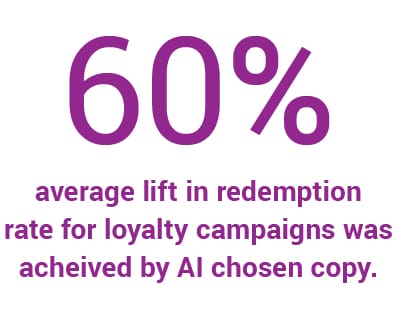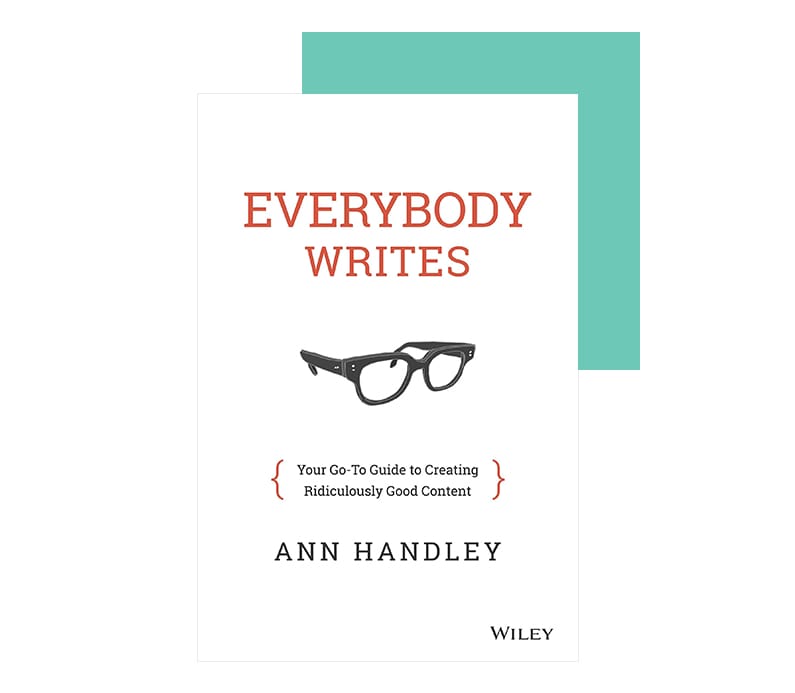Writing without jargon ensures you get the most from your marketing efforts.
Selling lemonade on a makeshift stand in your yard to passersbyers in the middle of summer may be profitable; doing it in the middle of winter definitely isn’t.
This example calls to mind the golden rule of marketing: make sure people want what you’re selling. When it comes to B2B marketing copy, there is an overwhelming demand for simple and scannable writing.
That’s why companies such as Persado exist–to make your company’s copy flow effortlessly while achieving maximum impact and reach through AI.
For example, Vodafone Italy brought-on Persado to amplify their customer service, as well as to prevent churn and re-engage former customers.
The result? Throughout the course of 2,000+ optimized campaigns, Vodafone witnessed a +42% uptick in the conversion rate for CRM, and a +60% average lift in redemption rate for loyalty campaigns.
Naturally, even though it’s an AI picking the words, the important part is that Persado delivers results. The point I’m making here is that even computers create simple and scannable writing.
You should, too.
If prospects and customers find that your copy isn’t conversational–it doesn’t sound like a human wrote it–your marketing efforts will fall flat.
But that doesn’t mean you should be “dumbing-down” your copy to make sure even the most hardheaded can read it. Neither does it mean you should code your copy with jargon so only your market understands it.
What you should do is write simply so you can get the most from your marketing investment.
Simple Writing Rejects Jargon
In fact, the use of marketing jargon is one of the biggest problems in the workplace. For starters, it excludes all of the people who may not know what those words mean.
Josh Bernoff, author of Writing Without Bullshit explains:
The more jargon you use, the more you are alienating large groups of people who should be reading and understanding what you write. You make them feel ignorant because they are ignorant; they don’t know your secret code. Some of them will work hard to figure it out, but most will just give up on you and whatever you’re trying to get across.
And listen, I get it. Using jargon is convenient. You can explain complicated concepts in a word or two. For example, consider the testosterone booster, Nugenix. In a commercial for the product, the marketers do a solid job of communicating what’s in it for the customer when discussing the ingredients.
But there is one point in the commercial where it does get a little jargon-y, and by that, I mean the ad’s language isn’t clear. Relying on shorthand for a risqué subject potentially confused the customers they were trying to reach.
At the 0:48 second mark of the commercial, its star, former baseball player, Frank Thomas, mentions to a woman who wants her husband to try the product, “And you’re going to like the difference, too.” To that, she flashes a cheesy smile.
The “difference” Thomas is talking about is a benefit of the product: an enhanced libido.
But this benefit relies heavily on suggestion and inference. Convenient for Nugenix, not for anyone else.
This underscores the larger point that you shouldn’t rely on suggestions or ask your prospects and customers to “figure it out.” When prospects and customers finally “get it” after the third or fourth commercial, your business will have spent significant resources with little or no return.
Simply put, relying on inference and suggestions to get around what you want to actually say is not the most effective way to get the most of your marketing investment.
To help this along, you want to ixnay the jargon and ineffective language in favor of explaining marketing concepts in clear, concrete words. Made to Stick: Why Some Ideas Survive and Others Die, by Chip and Dan Heath, really shines through here because it’s all about what makes an idea memorable.
More specifically, the Heath brothers spell out why exactly you should be using concrete words when trying to instruct:
Or maybe you’ve experienced the frustration of cooking from a recipe that was too abstract: “Cook until the mixture reaches a hearty consistency.” Huh? Just tell me how many minutes to stir! Show me a picture of what it looks like! …
…
Concrete ideas are easier to remember. Take individual words, for instance. Experiments in human memory have shown that people are better at remembering concrete, easily visualized nouns (“bicycle” or “avocado”) than abstract ones (“justice” or “personality”).
For example, consider Reese’s Take 5. Most notably, a commercial aired during the 2020 Super Bowl advertising the fact that the main ingredient of the chocolate candy is Reese’s peanut butter.
The commercial used idioms, which were represented in a concrete form for entertainment value. An unintended side effect of the commercial was that because these idioms were literal representations that showed up as concrete examples, the commercial was more likely to be remembered by Reese’s audience.
Such idioms included:
- Raised by wolves: Concretely fleshed-out by an office worker feasting with wolves in the workplace.
- From another planet: This one was pictured by a man’s head splitting open to reveal a sighing alien at the “controls.”
- Head-in-the-sand: The idiom was represented by a water cooler conversation between two coworkers–one with their head literally in a mound of sand, the other, not.
What you can take away from Reese’s example here is that there is tremendous potential in leveraging clear, concrete language. Reese’s found a sweet spot (no pun intended) by communicating what the idioms they used literally meant in an amusing way to connect with their audience.
Another reason to communicate clearly with no jargon in order to get the most from your marketing efforts.
Communicating Clearly Enables Teaching
Communicating clearly allows you to teach through writing.
You’re not merely giving marketing advice or product knowledge when you write a blog post or press release. You’re teaching your audience. Ann Handley, author of Everybody Writes, has a thing or two to say about the subject of teaching in writing:
Good, pathologically empathetic writing strives to explain, to make things a little bit clearer, to make sense of our world—even if it’s just a straightforward product description.
…
It’s easy to embrace the teaching mind-set when you’re writing a how-to or other bit of instruction. But the notion is broader than that. Strive to explain your point-of-view to the reader with evidence and context.
More of Handley’s lessons can be found here.
That last bit—“with evidence and context” is what teaching is all about. You want to write as though you’re explaining your topic to a kid. Shoot for a 9th-grade reading comprehension.
This isn’t because the reader can’t understand higher language—the lower target just takes less brain power. And after a long day, your brain can be fried crispy—you don’t want to think any more than necessary. So it’s best to assume your audience is unfamiliar with your topic.
This means you have to use examples to bring what you want the reader to know to life.
And one of the best ways to teach clearly as a marketer is to use an example. For instance, if you’re trying to communicate how effective concrete language can be, and your audience is other marketers, do some research and find a non-competing company that uses concrete language in their examples.
Simply do as I have done with the Reese’s Take 5 commercial example. In fact, let’s revisit that example to get a more precise handle on what exactly I’m trying to teach you about educating prospects and customers:
Below, I explain what the example is, how recently it aired, and its main objective:
“For example, consider Reese’s Take 5. Most notably, a commercial aired during the 2020 Super Bowl advertising the fact that the main ingredient of the chocolate candy is Reese’s peanut butter.”
Next, I explain how the commercial was done and why it’s effective. It helps that the Heath brothers’ research backed up the following claim:
The commercial used idioms, which were represented in a concrete form for entertainment value. An unintended side effect of the commercial was that because these idioms were literal representations that showed up as concrete examples, they were more likely to be remembered by Reese’s audience.
The last part of the example explains why it’s relevant for the audience to know:
What you can take away from Reese’s example here is that there is tremendous potential in clear language. Reese’s found a sweet spot (pun not intended) by communicating what the idioms they used literally meant in an amusing way to connect with their audience.
Your customers may not be other marketers, and that’s fine. You can merely substitute “marketers” with your audience and the lesson still applies.
But when teaching concepts in any type of marketing, you want to use concrete terms in your examples to explain them effectively. It’s not like you have anything to lose if you over-explain something–just make sure it adds value.
Remember, doing this doesn’t insult your prospects’ and customers’ intelligence–it’s more like assuming they don’t know anything about the specific topic you’re writing about. Summing up, if you write for everybody with clarity and focus, using concrete examples to illustrate your points, you’ll be sure you’re maximizing the gains on your marketing efforts.
Some things in life are just that simple.
What techniques have you found effective when you write simply? Drop us a note in the chat below to tell us about it.







